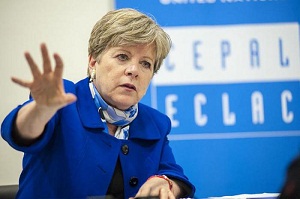 The Executive Secretary of the Economic Commission for Latin America and the Caribbean (ECLAC) outlined a complex period for the region’s economies in 2017, although she welcomed a return to modest, but positive, growth.
The Executive Secretary of the Economic Commission for Latin America and the Caribbean (ECLAC) outlined a complex period for the region’s economies in 2017, although she welcomed a return to modest, but positive, growth.
Responding to questions from Prensa Latina, Alicia Bárcena explained that an increase in U.S. Federal Reserve interest rates and rising commodity prices are expected for 2017.
She acknowledged that all expectations are pinned on the position the U.S. adopts with regard to the Latin American and Caribbean region when President-elect Donald Trump takes office on January 20, regardless of the protectionist tendencies evident in Europe.
“In any case, we must wait. Nobody has a crystal ball to see what will happen after January 20. We already have some ideas, but his (Trump) comments have not yet been applied in any specific area,” she stated.
Bárcena pointed out the risks of pushing toward protectionism, as well as greater nationalist trends in some countries, although there are no certainties that these could lead to anything particularly negative.
“Brexit, for example, has not had as many repercussions as might have been expected at first. The United States is something else, it is a very important neighbor; especially for Mexico and, in general, for all of Latin America and the Caribbean,” she added.
She noted that large U.S. companies continue to invest in Mexico and it is unclear whether remittances will see further taxes, “Therefore, it is necessary to view these issues with caution.”
Following a further question from Prensa Latina regarding the global economy, the head of ECLAC explained that her organization, the World Bank, and the International Monetary Fund, are speculating as to the effects of globalization.
There is an understanding that globalization can not be one-sided, must not accentuate inequality; this is a concern recently expressed by the incoming United Nations Secretary-General, Antonio Guterres, she noted.
Bárcena also referred to concerns about what is currently happening in European banking, what happened in Italy (a setback in reforms that forced the resignation of the prime minister) and a worrying scenario in France with upcoming elections.
However, the ECLAC Executive Secretary stressed that there are encouraging signs from China, following the recent visit of President Xi Jinping, who reiterated the commitment to invest in Latin America and the Caribbean.
In its annual Preliminary Overview of the Economies of Latin America and Caribbean 2016, the United Nations regional organization anticipated modest growth of 1.3% in 2017, after two consecutive years of economic contraction.
The analysis revealed that the Dominican Republic saw the greatest GDP growth in 2016, at 6.4% (with 6.2% growth predicted for 2017), followed by Panama (5.2% and 5.9% for 2017), and Nicaragua (4.8% and 4.7%), respectively.
Costa Rica (4.1% and 3.9% in 2017), Bolivia and Paraguay (both with 4% growth this year and 3.8% for the next period), and Peru (3. 9% and 4%), also stood out among the region’s economies.
“We are at a turning point. Latin America and the Caribbean will resume growth but moderately, and without clear engines driving it,” Bárcena concluded.
(Prensa Latina)